
Preventing suicide is the process of reducing the risk of people taking their own lives by identifying, treating and preventing them from doing so. This can be done at an individual level or at a society or community level.
Identifying people at risk
One of the most effective means of preventing suicide is to identify people at risk. The process of doing this involves an assessment of a person’s mental health and other factors that may increase or decrease their likelihood of dying from suicide.
A comprehensive risk assessment should involve a multidisciplinary team. It should also include a comprehensive risk formulation. This will help the practitioner to reach a clinical judgment about the level of risk posed by a patient. In addition, it should be carried out in a compassionate manner.
There are a number of methods to conduct a comprehensive risk assessment. These include asking a patient about their thoughts, life stress, frequency of thoughts, and their reasons for living. Identifying these factors may be beneficial for the individual at a higher risk, or for the community as a whole.
One method that has proven successful is using self-report computerized screening. This has been shown to be an accurate measure of a person’s risk of suicidal ideation.
Treating suicidal thoughts
Treatment for suicidal thoughts is a process that includes addressing the underlying causes of suicide. This is especially important for those who are seriously ill.
To prevent suicide, health care providers need to provide patients with a safe, structured environment. Ideally, this involves active engagement, regular safety planning, and reduced access to lethal means. These approaches should be integrated into clinical workflows.
For a health care system to provide optimal suicide prevention care, they must have an educated and trained workforce. They should also implement a structured approach to care, including regular safety planning, and motivational enhancement.
The CDC report recommends that communities develop a comprehensive public health approach to suicide prevention. It includes strategies to connect people at risk for suicide to coordinated care, increase temporary assistance options, and expand access to mental health care.
Suicide screening protocols should be embedded into electronic health records. They should also be completed in routine appointments. Asking about a patient’s thoughts of suicide, their intent, and their plan for suicide is a key component of the evaluation.
Preventing access to highly lethal items or places
Preventing suicide by restricting access to highly lethal items or places can save lives. These items and places include firearms, poisons, and other devices that can kill a person. A new report from the CDC identifies several strategies that communities can use.
For example, the CDC recommends that communities increase the number of help lines available. They should also support increased funding for school-based programs and integrated mental health care.
Reducing access to lethal means is a public health strategy that has a strong evidence base. It is not only effective, but it can reduce overall suicide rates.
This is because it changes the context of a potential suicide. People are more likely to use less lethal methods when a lethal method is not easily accessible. The time between thinking about suicide and attempting it is less than five minutes.
Access to potentially deadly medications is a challenge to prevent. Healthcare providers can educate patients on safe storage of these drugs.
Supporting a suicidal person
If you are worried about someone you know who is considering suicide, you need to take action. You can prevent suicide by removing a potential suicide method and by seeking professional help.
When you talk to a suicidal person, be non-judgmental, sympathetic, and direct. Offer to make a safety plan to keep them safe. This includes getting information about their general health and access to substances that could be used to kill them.
When you are unable to make the safety plan, call 911. It is the fastest way to get help for an emergency. But you should also stay with the person until help arrives.
If you are concerned about the person’s mental well-being, you can call a psychiatrist or other mental health professional. The mental health professional can provide support and help the person learn how to cope with their feelings.
There are also several strategies you can use to encourage your loved one to seek professional help. These strategies include offering a chance to talk about their feelings, helping the person develop a safety plan, and connecting them with a mental health professional.